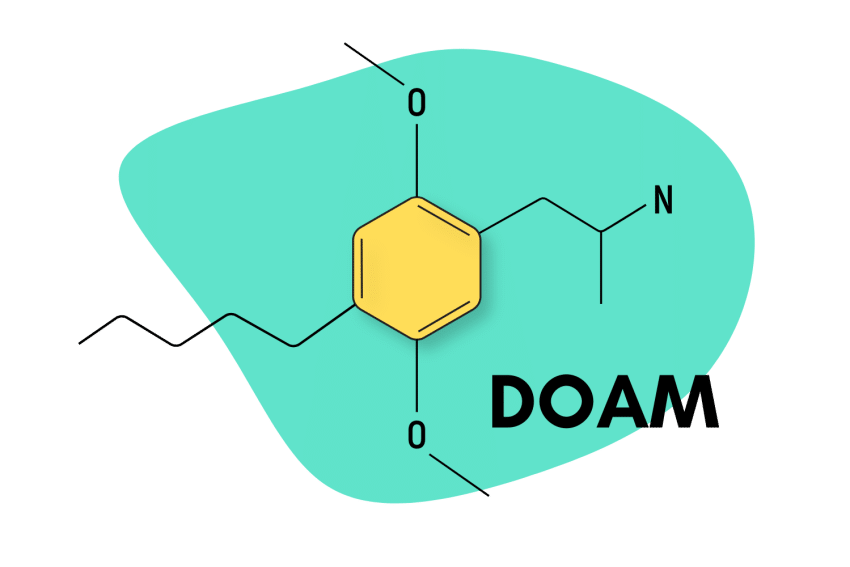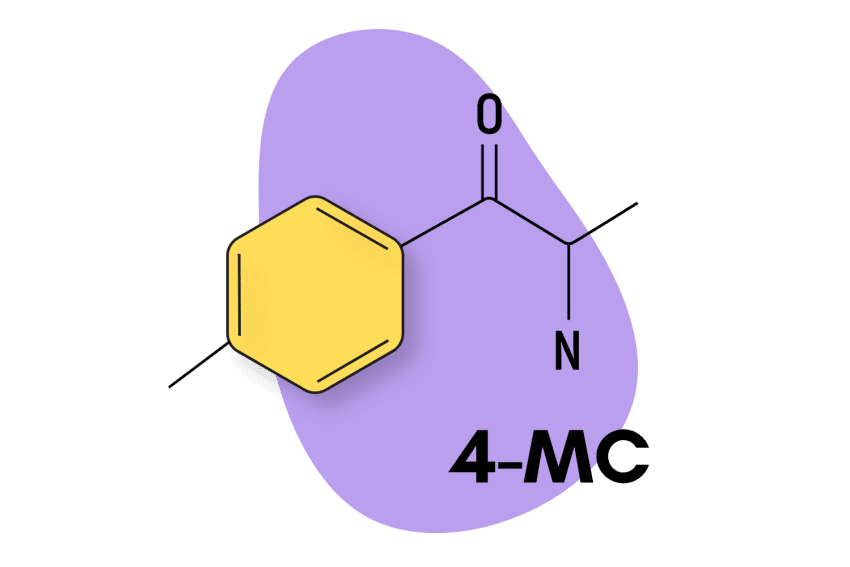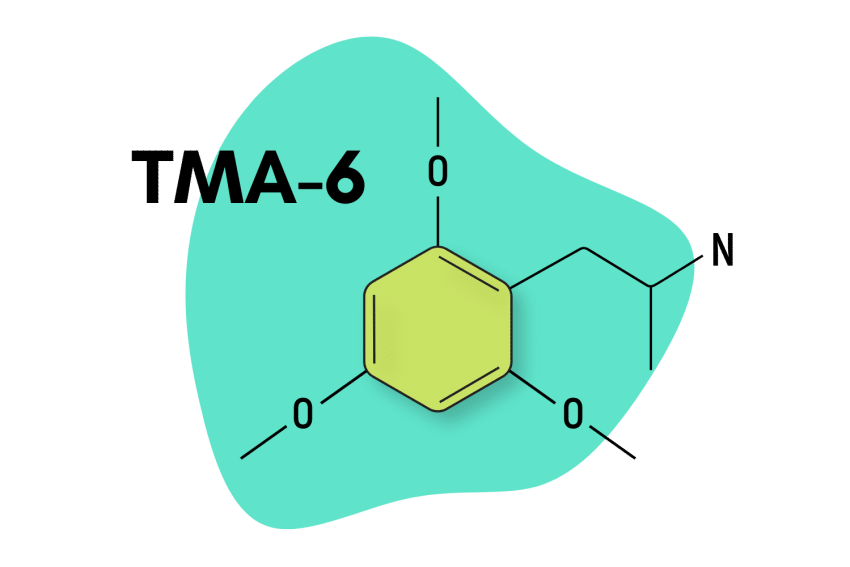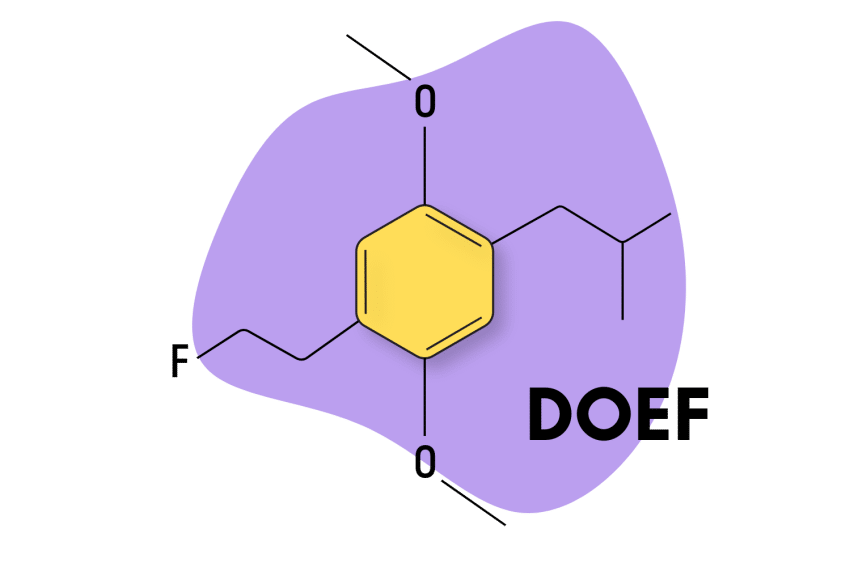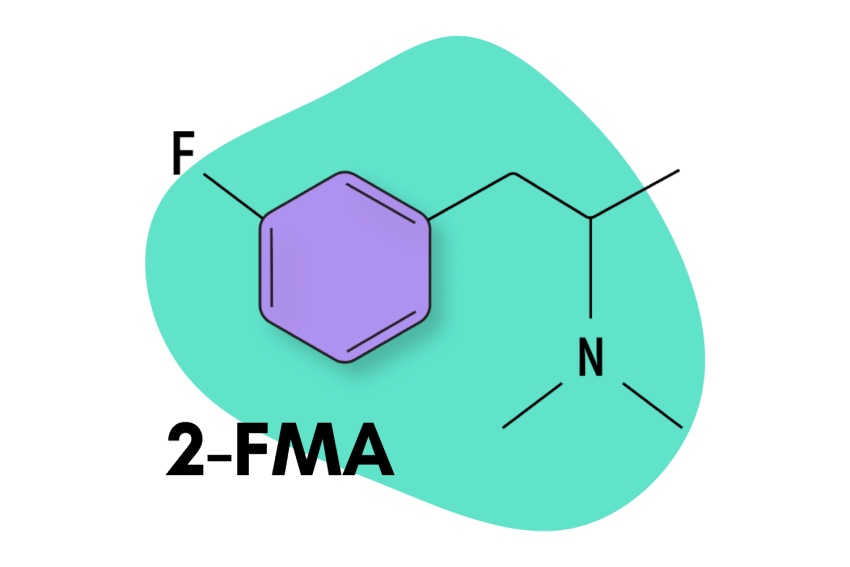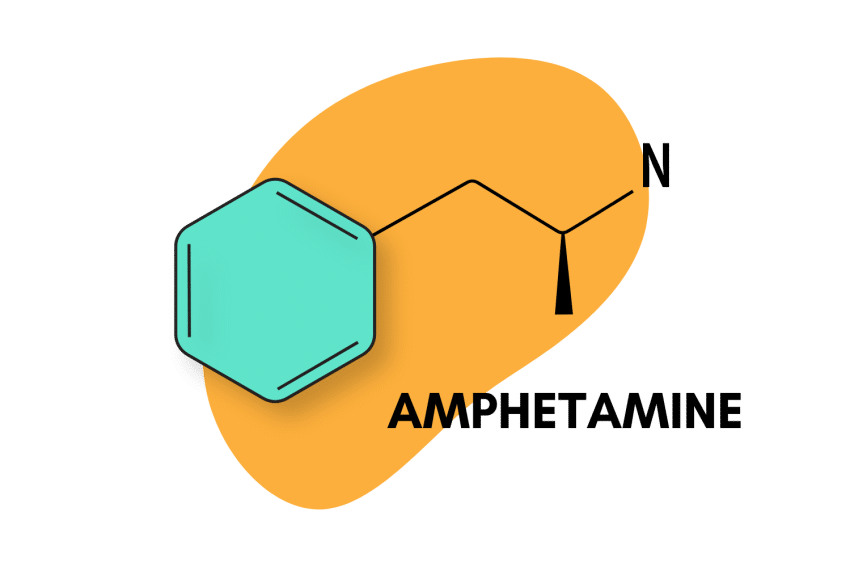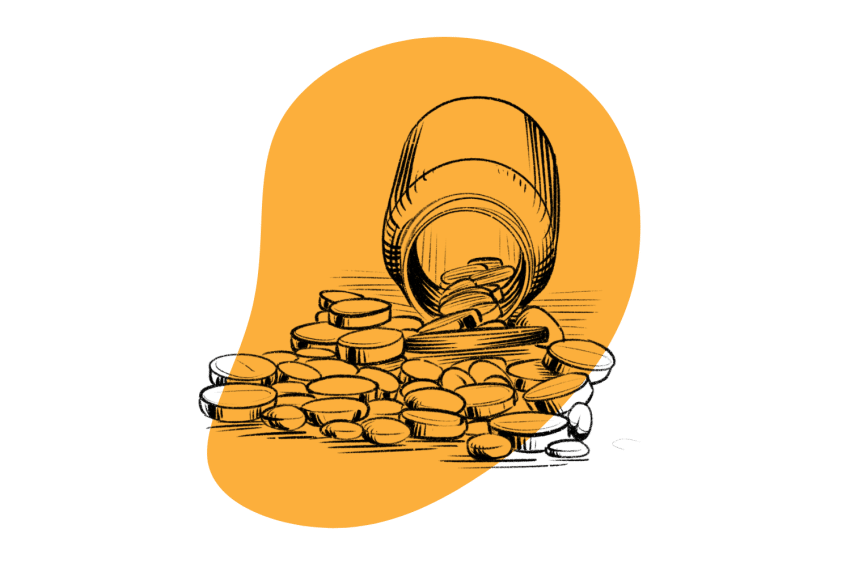DOI (2,5-Dimethoxy-4-iodoamphetamine): A Potent & Unique Psychedelic Compound
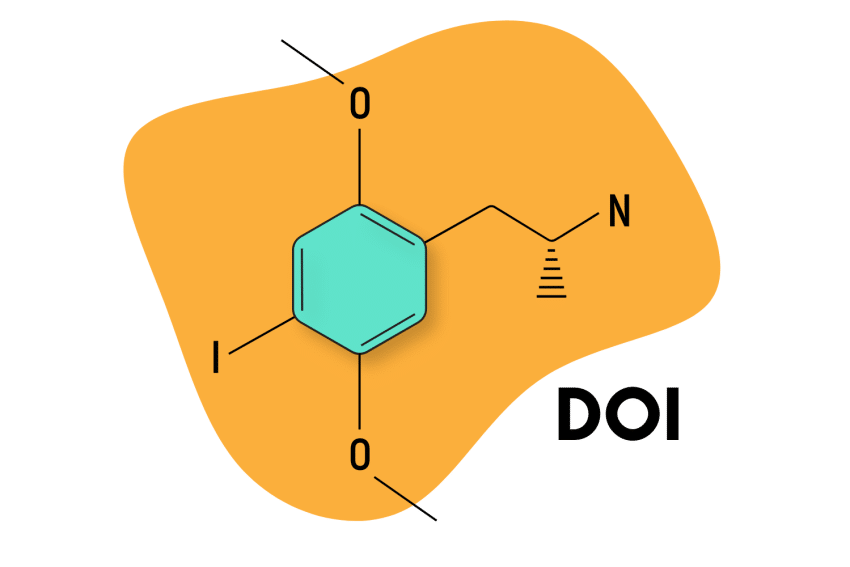
DOI is a psychedelic substituted amphetamine belonging to the DOX family of compounds.
Originally synthesized by Alexander Shulgin in the 1970s, The DOX subtype houses compounds known as substituted dimethoxyamphetamines, which can be thought of as a type of “middle ground” between psychedelics and stimulants.
Their effects can be described as producing deep psychedelic introspection with dramatic boosts in energy, vibrancy, and strong physical or tactile sensations.
As a class of drugs, DOX compounds take a long time to kick in (up to three hours) but last longer and are more potent than the related 2CX drugs.
In the case of DOI, this compound appears to be one of the strongest and most well-known members in its subtype.
Its thought that its elevated potency is the primary reason for the mixed review it generally produces. Many users believe DOI leads to bad trips and produces too many physical sensations to be a pleasant psychedelic, while other users claim its profile of effects is fantastic, stimulating feelings of bliss, strong but intriguing hallucinations, and long-lasting effects.
Despite some scientific interest in DOI as a treatment tool in psychedelic-assisted psychotherapy, it was officially added to the Controlled Substances list in the United States in April 2022.
DOI Specs
| Chemical Name | 2,5-Dimethoxy-4-iodoamphetamine |
| Level of Risk | Low |
| Other Names | DOI |
| Most Common Side Effects | Anxiety, paranoia, increased heart rate |
| Duration of Effects | 16 to 30 hours |
| Estimated Threshold Dose | 0.5 mg |
| Common Dose | 1 to 3 mg |
| Legality/Status | Research Chemical |
| PubChem ID: | 1229 |
| CAS# | 64584-34-5 |
Tripsitter Safe DOI Guidelines
- 🐍 I understand why psychedelics should be treated with respect
- ⚖️ I’m familiar with the laws for DOI in my country & state
- 🍄 I’m familiar with and confident in the dose I’m taking
- 🧪 I’ve tested a sample of the substance I’m using with a drug-testing kit
- 💊 I’m not mixing any medications or other substances with DOI
- 🏔 I’m in a safe & comfortable environment with people I trust
- 🐺 One of the members of my group is responsible and sober (AKA a trip sitter)
- ⏳ I have nothing important scheduled for after the trip
- 🧠 I’m in a sound & healthy state of mind
- ❤️ I don’t have any underlying health issues — don’t take DOI if you have underlying heart, neurological, or psychiatric disorders
- 👭 Use the buddy system — DOI can remove your inhibition and allow you to make unsafe decisions, always stay with people you trust, and never go out alone
- 🌵 I understand the risk of dehydration — it’s easy to become dehydrated on DOI, so make sure you’re drinking a cup of water every hour while using DOI
- 🦻 Protect your hearing — music can be intoxicating while on DOI, but protect your hearing and bring ear protection before you go out to a club or concert
How Does DOI Work?
DOI compounds, much like other substituted amphetamines, exert their effect on the body through their capacity to increase the receptor action of different neurotransmitter compounds.
Substituted amphetamines typically utilize three main pathways to achieve this goal:
- Inhibiting the reuptake of neurotransmitters
- Blocking the clearance of neurotransmitters
- Reversing the polarity of neurotransmitter transporters
The other significant factor in determining the given profile of a substituted amphetamine is the specific neurotransmitters it mediates. Dopamine, norepinephrine, and serotonin are the main neurotransmitters, although secondary transmitters do exist.
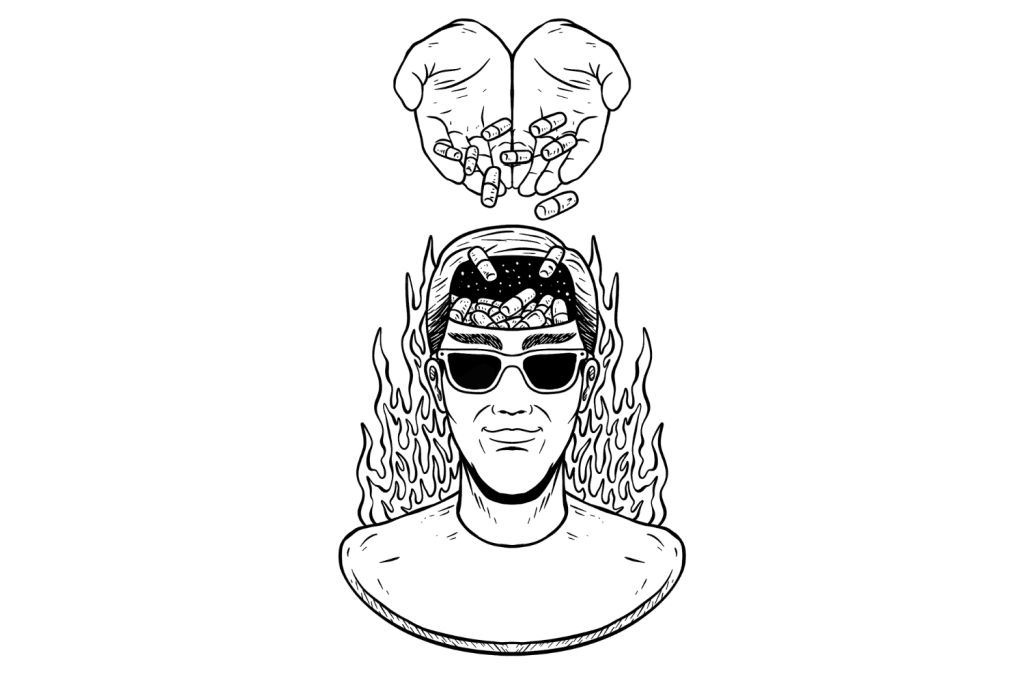
Neurotransmitters are the molecules that bind to receptors located in different areas throughout the body and interact with them to produce the pharmacological effects of amphetamines.
Usually, there is not much research on the pharmacology of designer drugs, but in the case of DOI, this psychedelic has actually received a fair amount of attention from scientists when compared to most other psychedelic compounds.
The exact pathway utilized by DOI is not completely understood, but researchers have pinned down its receptor activity with substantial accuracy. Depending on certain factors, DOI can act either as a partial or full agonist of the 5-HT2 serotonin subfamily of receptors: 5-HT2A, 5-HT2B, and 5-HT2C [1]. An agonist is a chemical that activates a receptor to produce the biological response associated with said receptor.
So, in this sense, we can see that DOI is an exclusively serotonergic compound and does not hold any affinity for dopamine and norepinephrine. Because of this, DOI isn’t considered a stimulant despite having a base amphetamine molecule.
It’s also important to understand that the number of receptors associated with serotonin is vast. In total, there are seven serotonin receptor families and 14 subtypes. DOI appears to have a very low affinity for other receptors but its real action centers around the 5-HT2 family. In fact, DOI is such a highly selective compound for the 5-HT2 receptors that it’s now used as a radioligand and indicator of the presence of 5-HT2 in other compounds.
The precise mechanisms by which 5-HT2 receptors produce psychedelia is not understood, but scientists now recognize this serotonin receptor family as the main instigators of psychedelic experiences, also being present in compounds such as psilocybin (magic mushrooms), mescaline, and LSD.
Out of the three 5-HT2 receptors, it appears that 5-HT2A is primarily responsible for the creation of the psychedelic response, although 5-HT2C does appear to have an important role in mediating said response [1].
What Are The Effects of DOI?
The effects of DOI are often compared to LSD, although there are some notable differences, especially in terms of pharmacokinetics. DOI is reported as being more stimulating than LSD, with more pronounced tactile and physical effects and a less complex “head space.”
Online drug forums, in-house testing, and various surveys have highlighted the following effect profile for DOI:
- Physical effects — Stimulation, Spontaneous physical sensations, Bodily control enhancement, Tactile enhancement, Nausea, Increased blood pressure, Increased heart rate, Muscle contractions, Muscle spasms, Vasoconstriction, Appetite suppression, Dehydration, Diarrhea, Increased perspiration, Pupil dilation, Teeth grinding, Increased salivation, Seizure
- Visual effects — Color enhancement, Patter recognition enhancement, Visual acuity enhancement, Drifting, Color shifting, Depth perception distorsion, Perspective distortions, Symmetrical texture repetition, Tracers, After images, Brightness alteration, Diffraction
- Cognitive effects — Conceptual thinking, Thought acceleration, Thought connectivity, Anxiety & Paranoia, Empathy, Affection, Sociability enhancement, Cognitive euphoria, Delusion, Analysis enhancement, Novelty enhancement, Personal bias suppression, Personal meaning enhancement, Immersion enhancement, Increased libido, Increased music appreciation, Increased sense of humor, Memory suppression, Ego death, Thought loops, Time distortion, Wakefulness
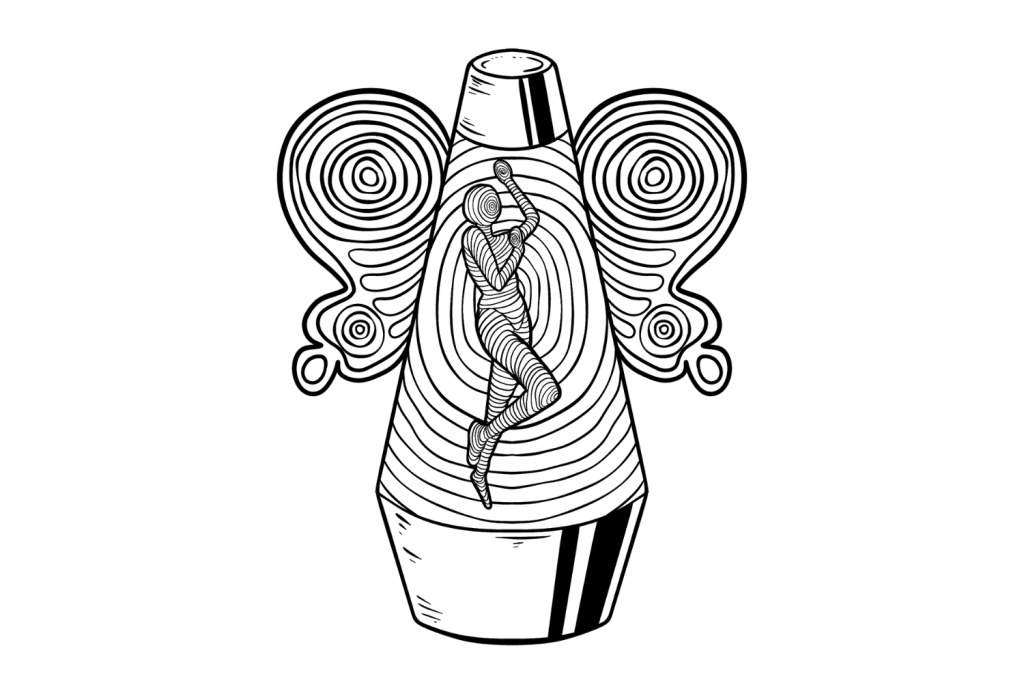
The stimulation produced by DOI seems to be the factor that most differentiates it from other psychedelics. Users often feel increased energy levels which may even become uncomfortable and overwhelming. DOI use may produce shakiness and unsteadiness of the hands, for example, as well as the desire to run around, dance, climb, and generally engage in physical activities. The experiences induced by other psychedelics are usually more sedating and relaxed.
Users also report a sort of “body high” that manifests itself as a mild energetic pins-and-needles sensation that encompasses a person’s entire body. This effect appears to be dose-dependent, which implies that, at high levels, it may become unmanageable. This would partly explain why many people find DOI’s body high unpalatable.
Is DOI Addictive?
DOI is not habit-forming. In general, psychedelic compounds have actually been found to be quite self-regulating. The experience of using DOI or other psychedelics can be so strong that many users prefer not to engage with them again. Usually, all but the most veteran users manifest the need to take a considerable amount of time before using psychedelics again.
However, psychedelics do produce tolerance within the body. So it could be posited that, in an extremely rare case, someone who has developed a psychological addiction to psychedelics would need to ingest more and more to keep receiving the same effects.
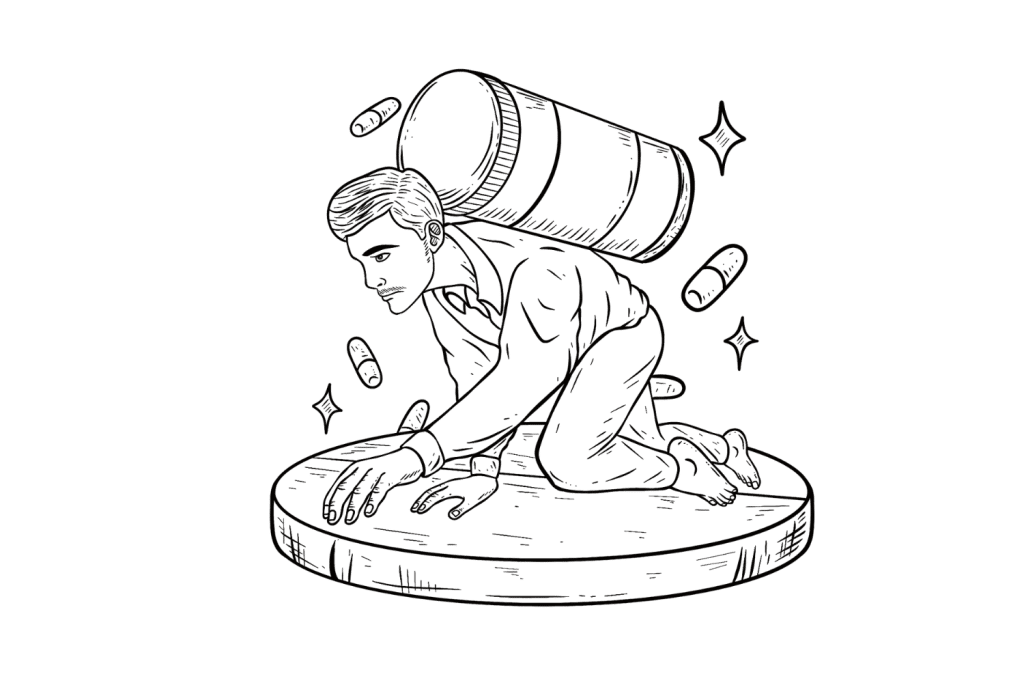
Tolerance to the effects of DOI is built almost immediately after ingestion. After that, it takes about 5-7 days for the tolerance to be reduced to half and 10-14 days to be back at baseline (in the absence of further consumption). DOI presents cross-tolerance with all psychedelics, meaning that after the consumption of DOI, all psychedelics will have a reduced effect.
Is DOI Safe? Risks & Side Effects
When compared with empathogenic, stimulant, and depressive substances, psychedelic drugs have the least inherent risks in terms of their effects on human physiology [2]. However, that does not mean they’re free of risk.
Serotonergic action in compounds like MDMA has been linked to cardiotoxicity and the depletion of serotonin levels in the brain. This depletion is especially acute in the days following MDMA use and is the cause for its much-loathed “after-effects.” There’s even some research that suggests these effects can be long-term. It is unclear whether these effects also apply to psychedelics, but it’s something to consider.

Strong serotonergic action also implies that DOI use could become dangerous if combined with other serotonergic compounds like certain antidepressants or MDMA. The combined serotonergic effect can lead to serotonin syndrome, a potentially life-threatening condition associated with increased serotonergic activity in the central nervous system.
The biggest risk in psychedelic use is the unpredictable nature of its effects on the psyche. Strong dissociative action and the loss of control it brings can make people have “bad trips,” which are often described as intensely negative experiences.
To avoid negative experiences, experienced psychedelic users often emphasize the importance of “set and setting.” “Set” refers to the mindset you bring to the experience. People going through a tough time psychologically, or even those who are more anxious or scared of what they might experience, tend to be more predisposed to bad trips. Setting is self-explanatory: it’s all about where and with who you are. Psychedelic experiences bring on a loss of normal functioning, so it’s important that users be in a place they’re comfortable with.
Harm Reduction: DOI
DOI is well studied pharmacologically, but human research is scant. This means that knowledge about its effects is based almost entirely on subjective self-reports, which warrants a healthy degree of speculation. Additionally, DOI is a relatively new substance, so there just hasn’t been enough time for people to understand it. Because of this, the utilization of harm-reduction practices is recommended.
DOI Dosage
The average (oral) dosing values for DOI break down as follows:
| Threshold | 500 to 750 ug |
| Light | 750ug to 1 mg |
| Common | 1 mg to 3 mg |
| Heavy | 3 mg and plus |
Remember: formulaic dosage prescriptions can never take into account individual variance. When trying a new drug for the first time, it’s always best to stay in the “threshold” range. Users must understand how their body reacts to the drug before moving on to higher ranges.

Due to the slow onset of effects for DOI and other DOX compounds, usually in the range of three to four hours, many users often believe they have received a “bum tablet” and thus re-dose. When the combined effects finally kick in, it can easily overwhelm the user and lead to a bad trip.
DOI: FAQs
What are the neuroplastic effects of DOI?
Psychedelic compounds that target the 5-HT2A receptor are reported to evoke psychoplastogenic effects, including enhanced dendritic arborization and synaptogenesis. Transcriptional regulation of neuronal plasticity-associated genes is implicated in the cytoarchitectural effects of serotonergic psychedelics. However, the transcription factors that drive this regulation are poorly understood.
Studies have shown that DOI can evoke an increase in the expression of several neuronal plasticity-associated genes in the rat neocortex in vivo. These results indicate that the hallucinogenic 5-HT2A receptor agonist DOI leads to rapid transcriptional upregulation of several neuronal plasticity-associated genes.

Neuroplasticity It is defined as the ability of the nervous system to change its activity in response to intrinsic or extrinsic stimuli by reorganizing its structure, functions, or connections after injuries, such as a stroke or traumatic brain injury. In other words, it’s the ability to “restructure” the way the brain has been shaped by experiences.
Does DOI act on receptors besides serotonin?
There does appear to be some evidence for the utilization of secondary neurotransmitters. For example, the reported affinities of DOI for α2- and β2-adrenergic receptors should be taken into account when considering DOI’s behavioral effects.
Certain studies have shown that DOI (above 12 nmol) increases dopamine release in the anterior striatum of anesthetized rats, an effect that was not blocked by the 5-HT2 antagonist, suggesting it may be mediated by DOI acting on α2-adrenergic receptors, which are known to regulate dopamine release in brain tissue. Also, cortical application of the α1/2 adrenergic antagonist, prazosin, blocked the 5-HT-releasing effect of DOI in the brain [3].
Does DOI have any other beneficial effects?
A study in LSU found that DOI administration can block pulmonary inflammation, mucus hyper-production, airway hyper-responsiveness, and turns off key genes in in lung immune response. These effects prevented the development of asthma in lab mice.
References
- Canal, C. E., & Morgan, D. (2012). Head-twitch response in rodents induced by the hallucinogen 2, 5-dimethoxy-4-iodoamphetamine: a comprehensive history, a re-evaluation of mechanisms, and its utility as a model. Drug testing and analysis, 4(7-8), 556-576.
- Nichols, D. E. (2016). Psychedelics. Pharmacological reviews, 68(2), 264-355.
- Bortolozzi, A., Amargós-Bosch, M., Adell, A., Díaz-Mataix, L., Serrats, J., Pons, S., & Artigas, F. (2003). In vivo modulation of 5-hydroxytryptamine release in mouse prefrontal cortex by local 5-HT2A receptors: effect of antipsychotic drugs. European Journal of Neuroscience, 18(5), 1235-1246.


